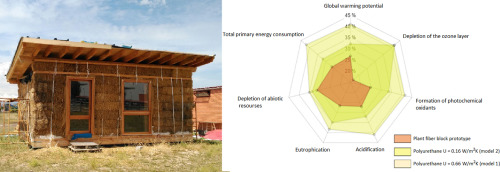当前位置:
X-MOL 学术
›
Sci. Total Environ.
›
论文详情
Our official English website, www.x-mol.net, welcomes your
feedback! (Note: you will need to create a separate account there.)
Environmental analysis of the use of plant fiber blocks in building construction.
Science of the Total Environment ( IF 8.2 ) Pub Date : 2020-04-06 , DOI: 10.1016/j.scitotenv.2020.138495 Marta Revuelta-Aramburu 1 , Amparo Verdú-Vázquez 2 , Tomás Gil-López 2 , Carlos Morales-Polo 1
Science of the Total Environment ( IF 8.2 ) Pub Date : 2020-04-06 , DOI: 10.1016/j.scitotenv.2020.138495 Marta Revuelta-Aramburu 1 , Amparo Verdú-Vázquez 2 , Tomás Gil-López 2 , Carlos Morales-Polo 1
Affiliation

|
Construction is a sector which produces high greenhouse gas emissions, which cause global warming. As such, it is becoming increasingly important to use sustainable materials which reduce the environmental impacts. The properties of the plant fiber block make it one of the most adequate building materials for the construction of the building envelope. However, there is no in-depth research that encompasses the extraction of the raw material, the transport to the factory and the manufacturing process. The present research analyzes the environmental impact associated with the production of plant fiber blocks as a building material, using the Life Cycle Assessment methodology. In addition to looking at the sustainability of this material, it also compares it with other conventional building materials. The results show that the impact category which made the biggest contribution in the manufacturing of a plant fiber block for its use in construction was that of the total primary energy consumption (9.74 MJ/kg straw). With reference to the emission of the greenhouse gases produced during manufacturing, the main contributors are the nitrogen and urea-based fertilizers used in cereal cultivation (0.73 kg of the total 0.96 kg of CO2 per kg of straw). However, the impacts caused by manufacturing a PFB are much lower than those produced from other insulating materials such as expanded polystyrene, extruded polystyrene or polyurethane foam (4.67E+03 kg CO2 eq. for the PFB compared to 1.23E+04 kg CO2 eq. for the fiberglass and 1.33E+04 kg CO2 eq. for the polyurethane).
中文翻译:

在建筑施工中使用植物纤维块的环境分析。
建筑是产生高温室气体排放的部门,导致全球变暖。因此,使用减少环境影响的可持续材料变得越来越重要。植物纤维块的特性使其成为建筑围护结构最合适的建筑材料之一。但是,没有深入的研究涵盖原材料的提取,到工厂的运输和制造过程。本研究使用生命周期评估方法分析了与植物纤维块作为建筑材料生产相关的环境影响。除了着眼于这种材料的可持续性外,还将其与其他常规建筑材料进行比较。结果表明,在用于建筑用植物纤维砖的制造中贡献最大的影响类别是一次能源总消耗(9.74 MJ / kg秸秆)。关于制造过程中产生的温室气体的排放,主要的贡献者是谷物种植中使用的氮和尿素基肥料(每千克秸秆中0.96千克二氧化碳中的0.73千克)。但是,生产PFB所产生的影响要比其他绝缘材料(如发泡聚苯乙烯,挤出聚苯乙烯或聚氨酯泡沫)所产生的影响要低得多(PFB为4.67E + 03 kg CO2当量,而1.23E + 04 kg CO2当量(对于玻璃纤维而言,则为1.33E + 04 kg CO2当量)。
更新日期:2020-04-06
中文翻译:

在建筑施工中使用植物纤维块的环境分析。
建筑是产生高温室气体排放的部门,导致全球变暖。因此,使用减少环境影响的可持续材料变得越来越重要。植物纤维块的特性使其成为建筑围护结构最合适的建筑材料之一。但是,没有深入的研究涵盖原材料的提取,到工厂的运输和制造过程。本研究使用生命周期评估方法分析了与植物纤维块作为建筑材料生产相关的环境影响。除了着眼于这种材料的可持续性外,还将其与其他常规建筑材料进行比较。结果表明,在用于建筑用植物纤维砖的制造中贡献最大的影响类别是一次能源总消耗(9.74 MJ / kg秸秆)。关于制造过程中产生的温室气体的排放,主要的贡献者是谷物种植中使用的氮和尿素基肥料(每千克秸秆中0.96千克二氧化碳中的0.73千克)。但是,生产PFB所产生的影响要比其他绝缘材料(如发泡聚苯乙烯,挤出聚苯乙烯或聚氨酯泡沫)所产生的影响要低得多(PFB为4.67E + 03 kg CO2当量,而1.23E + 04 kg CO2当量(对于玻璃纤维而言,则为1.33E + 04 kg CO2当量)。











































 京公网安备 11010802027423号
京公网安备 11010802027423号